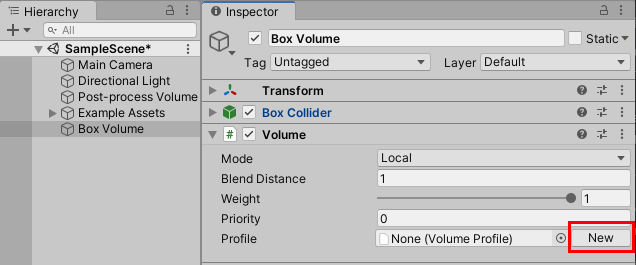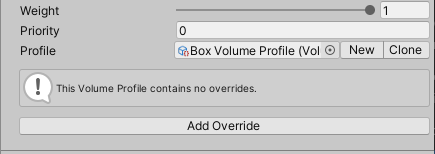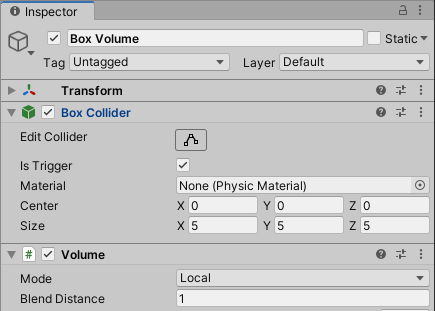Volumes
The Universal Render Pipeline (URP) uses the Volume framework. Volumes can override or extend Scene properties depending on the Camera position relative to each Volume.
URP uses the Volume framework for post-processing effects.
URP implements dedicated GameObjects for Volumes: Global Volume, Box Volume, Sphere Volume, Convex Mesh Volume.

The Volume component contains the Mode property that defines whether the Volume is Global or Local.

With Mode set to Global, Volumes affect the Camera everywhere in the scene. With Mode set to Local, Volumes affect the Camera if the Camera is within the bounds of the Collider. For more information, see How to use Local Volumes.
You can add a Volume component to any GameObject. A scene can contain multiple GameObjects with Volume components. You can add multiple Volume components to a GameObject.
The Volume component references a Volume Profile, which contains the Scene properties. A Volume Profile contains default values for every property and hides them by default. Volume Overrides let you change or extend the default properties in a Volume Profile.
At runtime, URP goes through all of the enabled Volume components attached to active GameObjects in the scene, and determines each Volume's contribution to the final Scene settings. URP uses the Camera position and the Volume component properties to calculate the contribution. URP interpolates values from all Volumes with a non-zero contribution to calculate the final property values.
Volume component properties
Volumes components contain properties that control how they affect Cameras and how they interact with other Volumes.

| Property | Description |
|---|---|
| Mode | Use the drop-down to select the method that URP uses to calculate whether this Volume can affect a Camera: • Global: Makes the Volume have no boundaries and allow it to affect every Camera in the scene. • Local: Allows you to specify boundaries for the Volume so that the Volume only affects Cameras inside the boundaries. Add a Collider to the Volume's GameObject and use that to set the boundaries. |
| Blend Distance | The furthest distance from the Volume’s Collider that URP starts blending from. A value of 0 means URP applies this Volume’s overrides immediately upon entry. This property only appears when you select Local from the Mode drop-down. |
| Weight | The amount of influence the Volume has on the scene. URP applies this multiplier to the value it calculates using the Camera position and Blend Distance. |
| Priority | URP uses this value to determine which Volume it uses when Volumes have an equal amount of influence on the scene. URP uses Volumes with higher priorities first. |
| Profile | A Volume Profile Asset that contains the Volume Components that store the properties URP uses to handle this Volume. |
Volume Profiles
The Profile field stores a Volume Profile, which is an Asset that contains the properties that URP uses to render the scene. You can edit this Volume Profile, or assign a different Volume Profile to the Profile field. You can also create a Volume Profile or clone the current one by clicking the New and Clone buttons respectively.
How to use Local Volumes
This section describes how to use a Local Volume to implement a location-based post-processing effect.
In this example, URP applies a post-processing effect when the Camera is within a certain Box Collider.
In the scene, create a new Box Volume (GameObject > Volume > Box Volume).
Select the Box Volume. In Inspector, In the Volume component, In the Profile field, click New.

Unity creates the new Volume Profile and adds the Add Override button to the Volume component.

If you have other Volumes in the scene, change the value of the Priority property to ensure that the Overrides from this Volume have higher priority than those of other Volumes.

Click Add Override. In the Volume Overrides dialog box, select a post-processing effect.
In the Collider component, adjust the Size and the Center properties so that the Collider occupies the volume where you want the local post-processing effect to be.

Ensure that the Is Trigger check box is selected.
Now, when the Camera is within the bounds of the Volume's Box Collider, URP uses the Volume Overrides from the Box Volume.